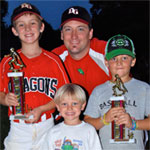Second Basemen Position Clinic
1. Making throws to first
Making throws to first is like playing catch. Take your time and make a good throw. You have time. Just make sure first baseman is turned and looking at you before you throw and your body is aligned properly, as always.
2. Making throws to second
There are several different throws you can make to second and they are all dictated by how far away from the base you are. First, there is the underhand toss. One thing to remember here, make sure your momentum is going toward the base and the ball is out of your glove before you flip. This is used from a close distance. Second, a little further from the bag, you’ll just rotate your upper body, pivot and throw. Make sure you point your shoulder at your target. Third, when you are in the hole, you will jump turn, plant and throw. Another way to throw from the hole is to turn your body so your back is toward home plate, plant and throw. These are a bit more difficult and take more body control. Again, ensure your body is in a good throwing position before you throw and make sure your momentum is going toward second base.
3. Turning double play
There are several ways to turn a double play and they are all dictated by the throw from the infielder. First, make sure you give the infielder a good target to throw at with your hands and glove up by your chest. The easiest and best way to receive the ball is to have your left foot on the middle to back side of the base as the ball is coming. You then come across the bag toward the throw as you catch the ball, plant and throw to first. The left foot on the bag is important because it keeps you out of the way of the runner and avoiding him sliding into your leg. A throw to your right now allows you stretch to your right, plant and throw. If you have the wherewithal, in this position you can even step back from the base and complete the throw. Keep in mind that the out at second is most important. If you have to alter your approach and act as a first baseman to get one out, do it. Better one out than none. After you have released the ball to first, get out of the way. Do not give the runner an opportunity to slide into you. If you can get out of the way, fine. If it’s a close play at second, a simple hop after you throw may be enough to avoid the runner sliding into you with your feet planted.
4. Covering second on steal
The textbook coverage is straddling the bag. Just make sure you make the tag quick and get in and out with glove hand only. It has to be the priority of the second baseman to catch the ball first, whatever the case.
5. Backing up second on steal
The only thing to think about when you know you are not covering the the bag on a steal is not to leave your position until after the pitch is through the hitting zone. Get yourself about 15-20 feet behind the bag to back up.
6. Positioning
With no one on base, play deeper to get more range. With a runner on first, get to double play depth. That is, don’t play so deep and get a few steps closer to second base. This will make getting to second base easier and quicker.
7. First step quickness
This requires a good creep step. The step sequence is right-left. Hands should be out in front of you, knees inside of feet, feet a little wider than shoulder width apart and weight on the balls of your feet in an athletic position. Some infielders like to take a hop after the creep step. Either way, creep step or creep step with a hop, you should time it to coincide the the pitch crossing the hitting area.
8. How to think as a second baseman
Getting good breaks on balls is all about timing and positioning. Knowing the hitter, the pitcher and the pitch to be thrown can all help. Always know what pitch is being thrown and adjust your position according. A step left or right can make all the difference in the world in getting to balls. Adjust your position according to how the hitter is swinging and/or how hard your pitcher is throwing as well. Think ahead as to what you are going to do before the ball is hit to you. Expect the ball.
Drills
- Take ground balls and throw to first.
- Feeding shortstop on double plays.
- Getting throws from shortstop and turning double plays.
- During playing catch; work on pivot throw to partner, short hops, getting ball out of glove quickly.
Fun advanced drills:
- Slow rollers and throwing to first.
- Making diving stops of ground balls.
- With a ball on the ground, have second baseman run to it, pick it up, turn and throw to second base.

